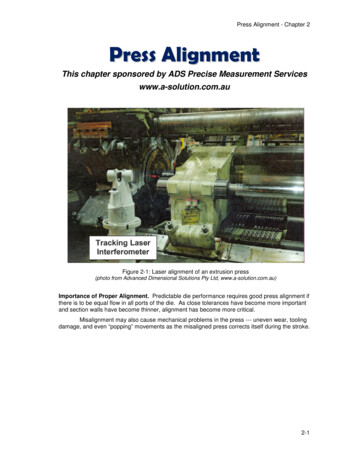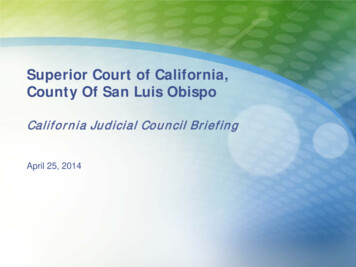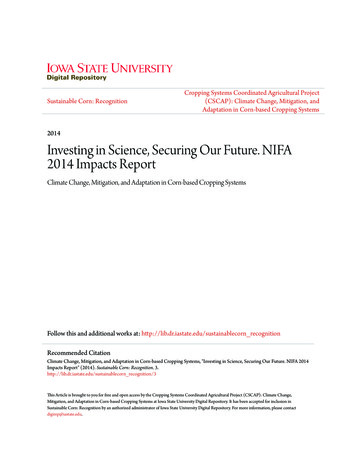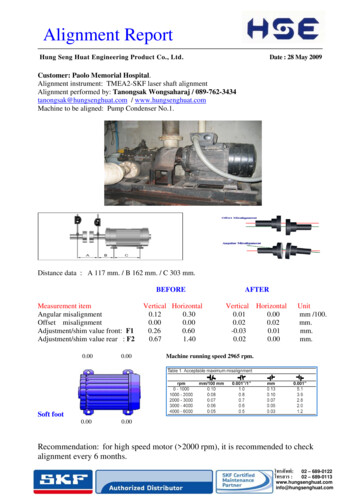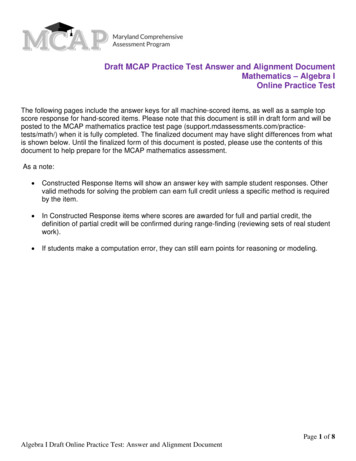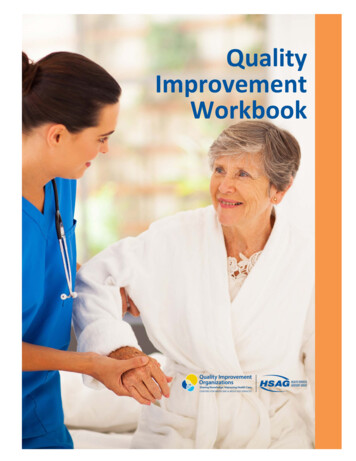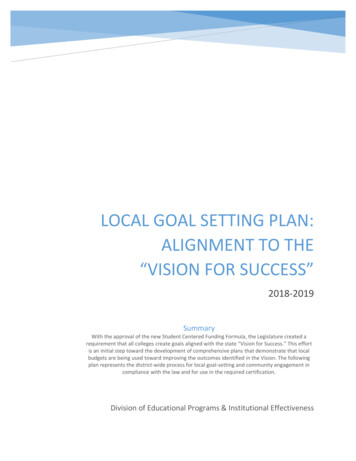
Transcription
LOCAL GOAL SETTING PLAN:ALIGNMENT TO THE“VISION FOR SUCCESS”2018-2019SummaryWith the approval of the new Student Centered Funding Formula, the Legislature created arequirement that all colleges create goals aligned with the state “Vision for Success.” This effortis an initial step toward the development of comprehensive plans that demonstrate that localbudgets are being used toward improving the outcomes identified in the Vision. The followingplan represents the district-wide process for local goal-setting and community engagement incompliance with the law and for use in the required certification.Division of Educational Programs & Institutional Effectiveness
BACKGROUNDAB 1809 represents the trailer bill language to the state budget established for the 2018-2019 fiscalyear. The bill established the new Student-Centered Funding Formula and creates additionalrequirements, including the need for each college to set local goals in alignment with the “Vision forSuccess.” The Chancellor’s Office has provided guidance and a timeline for completion of these efforts(Appendices A-C). The guidance indicates that colleges must meet two deadlines:Certification of goal setting process – December 15, 2018 (Submitted by college (CEO)Submission of Board approved goals – May 31, 2019 (Board, CEO, and Academic Senate President)The goal setting process is geared toward engaging the entire campus in a dialog on student success andthe establishment of ambitious goals. Specifically, the process requires establishing goals that are1) Are aligned with the system-wide goals in the Vision for Success,2) Are measurable numerically, and3) Specify the timeline for improvement.The required areas of alignment are:Completion Indicators: Completed associate degrees Completed CCCCO-approved certificatesTransfer Indicators: Completed Associate Degrees for Transfer (ADT) Transfers to UC/CSUUnit Accumulation indicator: Average units earned per completed associate degreeWorkforce Indicators: Median annual earnings of exiting students Number of exiting students earning a living wage Percent of exiting CTE students who report being employed in their field ofstudyEquity Indicators: All of the above indicators disaggregated for those student groups identified asdisproportionately impacted in the annual Equity Plan.The Chancellor’s Office further recommends a structured process with the ability for students, staffand faculty to participate. In addition, there should be ongoing engagement with the Boardthroughout the entire process. There is a deep connection to the new funding formula. All measuresPage 1 of 24
align directly or indirectly to metrics that are funded. There is a secondary process that will bedeveloped for next year that will make us demonstrate how funding is being used to achieve the Vision.DSP ALIGNMENTDuring the development of the District Strategic Plan, the values of inclusivity, creativity, vision andaccountability were used as guiding principles. Through the planning process, college and communityconstituents were engaged in the development of goals, objectives and measurable targets. Theresulting DSP is in complete alignment with the state Vision, including congruent targets. The followingis a summary of this alignment.State VisionOver five years, increase by atleast 20 percent the number ofCCC students annually whoacquire associates degrees,credentials, certificates, orspecific skill sets that preparethem for an in-demand job.DSPGoal 3 Objective 2: We willincrease completion of degreesand certificates.Congruent TargetA 20% increase in the numberof students who received adegree or certificateOver five years, increase by 35percent the number of CCCstudents system-widetransferring annually to a UC orCSU.Goal 3: Objective 3: We willincrease the number ofstudents transferring to fouryear institutions.A 20% increase in the numberof students who received acertificateA 35% increase in the numberstudents who transfer to aCalifornia Public, 4-yearinstitution (UC or CSU)Over five years, decrease theaverage number of unitsaccumulated by CCC studentsearning associate’s degrees,from approximately 87 totalunits (the most recent systemwide average) to 79 totalunits— the average among thequintile of colleges showing thestrongest performance on thismeasure.Goal 3: Objective 1: We willdecrease time to completion byenhancing academic andstudent support programs.A 35% increase in the numberstudents who transfer to a 4year institutionThe average number of unitsaccumulated by studentsearning an associate’s degree todecrease to 79 unitsA 20% increase in the numberof students who received adegreePage 2 of 24
State VisionOver five years, increase thepercent of exiting CTE studentswho report being employed intheir field of study, from themost recent statewide averageof 60 percent to an improvedrate of 69 percent— theaverage among the quintile ofcolleges showing the strongestperformance on this measureand ensure the median earninggains of the exiting students areat least twice the statewideconsumer price index.Reduce equity gaps across all ofthe above measures throughfaster improvements amongtraditionally underrepresentedstudent groups, with the goal ofcutting achievement gaps by 40percent within 5 years and fullyclosing those achievement gapsfor good within 10 years.DSPGoal 3: Objective 4: We willincrease career and jobplacement rates in the field ofstudy by enhancing businessand industry partnerships,internships, and employmentopportunities.Congruent TargetIncrease the percentage ofstudents who report beingemployed in their field of studyto 69%Goal 3: Objective 6: We willincrease equity in theattainment of studentmilestones.A 40% decrease in achievementgap (by Gender, Age, andEthnicity) for the percentage ofnew students who are enrolledin their first 3 consecutive termsA 40% decrease in achievementgap (by Gender, Age, andEthnicity) for the percentage ofnew students completing 30Units in 3 YearsA 40% decrease in achievementgap (by Gender, Age, andEthnicity) for the percentage ofnew students who earned adegree, certificate, or transferwithin six yearsGiven this alignment, the college goal setting can utilize the DSP as a starting point for the local goalsetting process. Throughout the development process, it was made clear that while the District wouldhave concrete targets for improvement, the college specific targets may differ based on their localcontext. The current process will allow the colleges to establish these local goals within the stateframework, but with consideration of the local achievement, priorities, and other constructs. Anadditional consideration for the colleges will be timing. While the DSP runs through 2023, the stateguidance asks for targets concluding in 2022. This could lead to differences in some targets.Page 3 of 24
GOAL SETTING PROCESSNovemberThe month of November will focus on informing and building consensus for the goal setting process. Thefollowing activities will occur.MonthNovemberDistrict FunctionPresent overview of Process toIESS to begin Boardengagement process.Review LaunchBoard data andprovide template reports forcolleges to use for initialengagement that align withDSP.College FunctionReview general goals settingplan template with collegeconstituents.Establish detailed timeline forreview and approval throughthe shared governancestructures.Plan local engagementactivities.DecemberThe month of December will focus on final approval of local goals setting plans and submission to theChancellor’s Office.MonthDecemberDistrict FunctionContinue to work withChancellor’s Office data asavailable and provide collegelevel data to each college.Present an item on the BoardAgenda notifying the Board thatthe goal setting plans weresubmitted.College FunctionCollege finalizes local plan andtimelineCEO submits plan certificationto the Chancellor’s Office.JanuaryGiven the winter break, the month of January will focus on continued data collection and preparationfor spring engagement. The District will work collaboratively with the colleges to complete this work.February-MarchEach college has unique governance structures and processes for engaging their campus communities.During the initial months of the Spring semester, the colleges will use their local processes to discussand establish the local goals and submit them using a common template (Appendix D).Page 4 of 24
MonthFebruary-MarchDistrict FunctionSupport colleges and attend anypresentations, forums orcommittees as requested.College FunctionBegin goal setting engagementprocess based on the collegeplan.Attain Academic Senate andShared Governance approvalsfor submission to BoardApril - MayThe colleges will complete goal setting by the end of the first week of April. The college template will besubmitted to the District and the draft goals will be presented for review to the IESS Committee onApril 17th. The final goals will be presented as a Chancellor’s Item for approval by the Board at the May1st meeting. Following approvals, EPIE will coordinate the collection of required materials for submissionto the state by the college CEO.Page 5 of 24
Appendix ANovember 5, 2018AA 18-59 Via EmailTO: Chief Executive OfficersChief Instructional OfficersChief Student Services OfficersChief Business OfficersAcademic Senate PresidentsResearch and PlanningDirectorsFROM: Laura L. HopeExecutive Vice Chancellor, Educational Services andSupport RE: Local Goal-Setting GuidanceBACKGROUNDIn July 2017, the California Community Colleges (CCC) Chancellor’s Office releasedVision for Success: Strengthening the California Community Colleges to MeetCalifornia’s Needs. Citing the economic and educational needs of California, thisdocument established a vision for improvement, including clear goals and a set ofcommitments needed to reach those goals.The Vision for Success deliberately included just a handful of concrete studentoutcome goals in order to establish a clear message about what matters most, and aclear and simple focus for the system as a whole. The ultimate aim of the CCCs is tohelp students complete their educational goals—whether a degree, certificate,transfer, or good job. The Vision for Success goals reflect this ultimate mission, as well asthe need to serve the State of California efficiently and equitably.Chancellor’s Office, Academic Affairs1102 Q Street, Sacramento, California 95811 Sixth Floor eduPage 6 of 24
Appendix ALocal Goal-Setting GuidanceNovember 5, 2018The goals of the Vision for Success are summarized as follows:GOAL 1: CompletionSystemwide, increase by at least 20 percent the number of CCC students annuallywho acquire associate degrees, credentials, certificates, or specific job skill sets thatprepare them for in-demand jobs by 2021-22.GOAL 2: TransferSystemwide, increase by 35 percent the number of CCC students transferring annuallyto a UC or CSU by 2021-22.GOAL 3: Unit AccumulationSystemwide, decrease the number of units accumulated by CCC studentsearning associate degrees, from an average of approximately 87 total units to anaverage of 79 total units by 2021-22.GOAL 4: WorkforceSystemwide, increase the percent of exiting CTE students who report being employedin their field of study, from the most recent statewide average of 69% to 76% by 202122.GOAL 5: EquitySystemwide, reduce equity gaps across all of the above measures through fasterimprovements among traditionally underrepresented student groups, with the goal ofcutting achievement gaps by 40 percent by 2021-22 and fully closing thoseachievement gaps for good by 2026-27.In July 2018, the Governor and the Legislature established a new funding formula for theCCCs [AB 1809, Chapter 33, Statutes of 2018]. That legislation also sought to morestrongly link financial planning with broader educational planning. Specifically, itestablished that districts must take certain actions, including the adoption ofcollege- level performance goals that:1)2)3)Are aligned with the systemwide goals in the Vision for Success,Are measurable numerically, andSpecify the timeline for improvement.Page 7 of 24
Appendix ALocal Goal-Setting GuidanceNovember 5, 2018Additionally, the law specified that local community college boards of trustees must:1)2)3)Adopt the goals at a board meeting,Include in that meeting’s agenda an explanation of how the goals areconsistent and aligned with the systemwide goals, andProvide the written agenda item and summary of action to the Chancellor’sOffice.Finally, the law requires that each local board:1)2)Align its comprehensive plan to its local goals andAlign its budget with the comprehensive plan.The remainder of this document explains what districts should do to meet therequirements of the new law and provides guidance on how to take advantage ofthis unique opportunity to review data, establish or reaffirm college priorities, and setambitious goals for the future. Consistent with the Vision goals, local goals must beaggressive and aspirational if we are to meet the State’s needs.PROCESS AND TIMELINEThere are two firm deadlines associated with the local goal-setting process: By December 15, 2018: Colleges must certify to the Chancellor’s Office that aprocess is underway to set measurable, aligned goals. This will be a simplecertification process that can be done online. By May 31, 2019: District boards must adopt goals and submit them to theChancellor’s Office. This will be done using the online Local Goals ReportingForm that will be available by the end of 2018 and must be signed by the BoardPresident, Chief Executive Officer, and Academic Senate President.In order to meet the May 31 deadline, the Chancellor’s Office suggests the followingapproach and timeline:Page 8 of 24
Appendix ALocal Goal-Setting GuidanceNovember 5, 2018Review of Baseline DataRecommended Timing: November-December, 2018Every year, districts should review the most recent data on their colleges’ performance.From this year forward, districts should specifically use the new Student Success Metrics(formerly known as the Simplified Metrics) available on the Launchboard for thisactivity. The first version of this dashboard will be available by late October 2018 andwill only include high-level data. By February 15, 2019, the dashboard will have thecomplete set of metrics and all the drill-downs for equity purposes. Compared to theStudent SuccessScorecard, the Student Success Metrics provide a narrower set of indicators specificallydesigned to be aligned with the systemwide goals in the Vision for Success. Inpreparation for setting local goals, districts should especially focus on the followingindicators:Completion Indicators: Completed associate degreesCompleted CCCCO-approved certificatesTransfer Indicators: Completed Associate Degrees for Transfer (ADT)Transfers to UC/CSUUnit Accumulation indicator: Average units earned per completed associate degreeWorkforce Indicators: Median annual earnings of exiting studentsNumber of exiting students earning a living wagePercent of exiting CTE students who report being employed in their field ofstudyEquity Indicators: All of the above indicators disaggregated for those student groups identified asdisproportionately impacted in your annual Equity Plan and available in theStudent Success Metrics on the LaunchboardPage 9 of 24
Appendix ALocal Goal-Setting GuidanceNovember 5, 2018Certify to Chancellor’s Office that a Goal-Setting Process is UnderwayRequired by December 15, 2018College Chief Executive Officers (CEOs) will certify that a goal-setting process isunderway or completed at their college using a simple template that theChancellor’s Office will provide in November 2018 through a survey instrument.College CEOs will communicate to the Board President that this certification hasoccurred.Review of Existing Plans and PrioritiesRecommended timing: January, 2019Districts do not need to start this process with a blank slate. Virtually all colleges willhave an existing strategic plan or educational master plan. These plans may also existat the district level. Working together, district and college leaders should look to theseplans to identify current improvement priorities as a starting point for developing localgoals that comply with the requirements of the new law.If existing plans already include numeric goals to improve degree/certificateattainment, transfer attainment, job placement, or wage gains, then district andcollege leaders should use those as a starting point, but they should review them inlight of the most current data and the systemwide Vision for Success goals to evaluateif more ambitious goals are appropriate and necessary.If existing plans have improvement goals but they are not stated in numeric termsand/or do not specify a timeline for achieving the goals, district and college leadersshould use the local goal-setting process to develop those features and incorporatethem into their strategic plans or educational master plans moving forward.Setting GoalsRecommended Timing: February-April, 2019The Chancellor’s Office strongly encourages colleges to use the process of settinglocal goals as an opportunity for community dialogue about the priorities andperformance of the college. Community forums, student focus groups, and thecollege’s standard consultative practices are all sources of input for determining whatthe college aims to accomplish over the coming three years. Many colleges alreadyhave established processes and forums for identifying goals for the InstitutionalEffectiveness PartnershipPage 10 of 24
Appendix ALocal Goal-Setting GuidanceNovember 5, 2018Initiative or other initiatives. These can be re-purposed for the work of local goalsetting as well.As districts and colleges begin work on setting goals, the following discussion questionscan be used to elicit feedback from a variety of stakeholders:1)All CCCs are different. How is this one unique?2)Strengths: Is this college strongest at helping students complete AA degreesand certificates? Transferring to a 4-year college? Reaching a workforcegoal? In which of these areas can we build on our previous successes overthe next three years? What is an ambitious target for excelling beyond ourcurrent performance by the year 2021-22?3)Areas for improvement: Where could we be doing a better job in helpingstudents reach their end goals? What is an ambitious but achievabletarget for improvement in these areas by the year 2021-22?4)Our students on average take units to complete a degree or transfer.Why is this? What is the impact on students and our college? How much canweimprove in this area by the year 2021-22?5)percent of our CTE graduates find a job in their field of study. Is this asuccess story that we can build on or an area that needs improvement?How much could we improve by the year 2021-22?6)Which of our student groups are most in need of support and assistance toreach their degree, transfer, or workforce goals? Where should weparticularly focus our efforts to help them? What is an ambitious butachievable target for doing so by the year 2021-22?Following their activities to gather input, college officials will need to work together withtheir district leadership to set a handful of specific, measurable goals for the followingset of indicators:Page 11 of 24
Appendix ALocal Goal-Setting GuidanceNovember 5, 2018Completion Indicators: Completed associate degrees AND Completed CCCCO-approved certificatesTransfer Indicators: Completed ADT degrees OR Transfers to UC/CSUUnit Accumulation Indicator: Average units earned per completed associate degreeWorkforce Indicators: Median annual earnings of exiting students OR Number of exiting students earning a living wage OR Percent of exiting CTE students who report being employed in their fieldof studyEquity Indicators: Each selected indicator from the above list, disaggregated for thosestudent groups identified as disproportionately impacted in your annualEquity Plan and available in the Student Success Metrics on theLaunchboardChoosing from the above set of indicators, as specified, will ensure that districts andcolleges are in compliance with the law. Of course, districts and colleges may chooseto set more goals than the minimum required (e.g. choosing more than one workforceindicator listed above, or adding additional indicators from the Student SuccessMetrics, or adding other metrics that are important in the local context of thecollege). Districts may choose to report these additional metrics to the Chancellor’sOffice or to simply incorporate their additional goals into local plans andcommunications. However, since they are not required, additional goals and metricswill not be included in the system’s reports on local goals. Ideally, a district’s final set ofgoals will be narrow and targeted enough to help focus the entire college communityon a plan of action.Adopting Goals and Role of Local BoardsAlthough colleges will lead the process of setting local goals, local boards of trusteeswill formally adopt each college’s goals. To ensure that the goals being set areappropriate and in line with district needs and priorities, trustees should be seriouslyengaged in the entire goal-setting process. Local board members may attendcommunity forums and student groups as well as participate in standard consultativePage 12 of 24
Appendix ALocal Goal-Setting GuidanceNovember 5, 2018practices with stakeholder groups on campuses. It is the role of the board to balancethe interests of many groups and approve goals that are best for students and thecommunity at large. For this reason, boards should ensure that student voice isincluded in a meaningful way in the goal- setting process. Boards should also strive toapprove goals that are equal in ambition to those established for the entire system inthe Vision for Success. If there is a change in board leadership during this process, it isthe CEO’s responsibility to engage the new leadership in the goal-setting process.Once goals are finalized in collaboration with district and college leadership, boardsmust include them in a written board meeting agenda and formally adopt them at apublic meeting (as required by law). The written agenda item should include anexplanation of how the goals are consistent and aligned with the systemwide goalsarticulated in the Vision for Success. By using the Local Goals Reporting Form that theChancellor’s Office will provide in December and the timeline outlined here, boardscan be assured that the colleges are in compliance with this requirement.Reporting Local GoalsRequired by May 31, 2019The Chancellor’s Office will provide a Local Goals Reporting Form—a fillable, onlinetemplate to assist districts in reporting their goals in compliance with state requirements.This template will ask districts to express their goals using specified indicators from theStudent Success Metrics on the Launchboard. For the purpose of uniformity, all goalsshould be reported with an endpoint of 2021-22.When reporting their goals to the Chancellor’s Office, boards should also submit thewritten agenda item regarding local goal setting and a summary of the board’saction on the item (as required by law).Page 13 of 24
Appendix ALocal Goal-Setting GuidanceNovember 5, 2018ASSISTANCE FOR DISTRICTS AND COLLEGESIn addition to the process certification form and this accompanying guidance, theChancellor’s Office will develop the following resources by November, 2018 in orderto assist districts in setting local goals: A one-stop shop on the Vision Resource Center that compiles allresources related to local goal setting, The Student Success Metrics data on the Launchboard for reviewingbaseline data for the specific indicators that will be used in the goalsetting process, A Frequently Asked Questions document, An infographic and PowerPoint for explaining the goal-settingprocess to various audiences, An example of the Local Goals Reporting Form so colleges can start theirwork (a fillable, online version of this Form will be available in December).PLAN AND BUDGET ALIGNMENTThe law establishing the funding formula and local goal-setting process also requiresthat each district ultimately align its “comprehensive plan” with its adopted localgoals and align its budget with the “comprehensive plan.”By May 31, 2019, all CCCs will have established local goals in alignment with thesystemwide goals established in the Vision for Success. Districts should considerincorporating their newly adopted local goals into their educational master plans,strategic plans, and other districtwide planning documents. The process of aligningthe local goals to plans should be visible to the public and should also align with thedistrict’s budget allocation process.Throughout 2019, the Chancellor’s Office will be working to revise and combine reportingrequirements for Guided Pathways, Student Equity, and other major reports to assistdistricts in fully complying with the requirement to align their comprehensive plans withlocal goals. The Chancellor’s Office will also provide guidance around aligningbudgets with comprehensive plans. Colleges will not be expected to submit theircomprehensive plans and aligned budgets until May 31, 2020.Page 14 of 24
Appendix ALocal Goal-Setting GuidanceNovember 5, 2018TIMELINE 2018November:Release of guidanceGoal Process Certification sent to CEOs via survey instrumentAggregate Student Success Metrics data available on theLaunchboard for reviewing baseline data for the specific indicatorsthat will be used in the goal-setting processFollowing materials available on the Vision Resource Center: Guidance Link to the Student Success Metrics (formerly known asthe Simplified Metrics) data on the Launchboard A Frequently Asked Questions document An infographic and PowerPoint for explaining the goalsetting process to various audiences An example of the Local Goals Reporting Form so colleges canstart their workDecember: Online, fillable Local Goals Reporting Form available on VisionResource CenterDecember 15: Deadline for CEOs to submit Goal Process Certification to Chancellor’sOffice2019February 15: The Launchboard will have the complete set of Student Success Metricsand all the drill-downs for equity purposesMay 31:Deadline for districts and colleges to submit the completed LocalGoals Reporting Form to the Chancellor’s OfficeSummer:Chancellor’s Office releases streamlined reporting requirementsPage 15 of 24
Appendix ALocal Goal-Setting GuidanceNovember 5, 2018CONCLUSIONThe Chancellor’s Office encourages all colleges to treat the new local goal-settingrequirement as much more than a compliance exercise. It is an opportunity to bringtogether college personnel, district leaders, students, and communities to ensure thatevery college has a clear, shared vision for student success. Once established, thisshared vision can provide a foundation for planning, prioritizing, and making decisions,improvements, and adjustments along the way. Beyond these internal benefits, thelocal goal-setting process is an opportunity for the CCC system to show California thatit is committed to their mission of helping all students reach their educational goals.Working together as a system, we can meet our ambitious systemwide goals forimprovement.cc: Sandy Fried, Foundation for California Community CollegesStacy Fisher, Foundation for California Community CollegesKevin Wutke, Foundation for California CommunityCollegesPage 16 of 24
Appendix ALocal Goal-Setting GuidanceNovember 5, 2018Local Goal Setting FAQsAre colleges and districts required to follow this process?Yes. In July 2018, the Governor and the Legislature established a new funding formula forthe California Community Colleges [AB 1809, Chapter 33, Statutes of 2018]. In thatStatute, colleges/districts are required to establish the following:1. Local goals that are aligned with the system-wide goals in the Vision for Success2. Local goals that are numerically measurable3. Local goals that specify the timeline for improvementThe Chancellor’s Office is requiring that the CEOs certify that plans for an inclusive processto establish these goals are in place by December 15, 2018. This certification will becompleted through a survey instrument that will automatically submit to the Chancellor’sOffice. By May 31, 2019, the Chancellor’s Office is requiring the completion of thesubmission of these goals that also includes the signatures of the Board President, CEO,and Academic Senate President.The Chancellor’s Office expects each college will have a unique process that incorporatesthe goals of the college community as well as the community the college serves. Since thelocal community is the group to which the college is ultimately accountable, it is importantto include their voices in the process, as well as the internal stakeholders and leaders,including faculty, classified professionals, and students. Many colleges have utilized similarprocesses when establishing the Institutional Effectiveness Partnership Initiative (IEPI) goals inthe past.Are the local goals local to the colleges or to the districts?Each college should develop a distinct set of goals; however, the district may want tocoordinate the efforts in a multi-college district to assure that goals map back to districtplans. Further, district boards will be reviewing and approving college-specific goals forthose within their service area.Page 17 of 24
Appendix ALocal Goal-Setting GuidanceNovember 5, 2018Should the goals be aspirational or pragmatic in terms of thecolleges’ capacity to reach them?Like the Vision for Success, colleges should set ambitious goals and agendas to propelstudent achievement forward. These goals should guide the colleges for the next five years.If the goals are achieved more quickly, they can always be recalibrated. Setting ambitiousgoals is a way of confirming
The goal setting process is geared toward engaging the entire campus in a dialog on student success and the establishment of ambitious goals. Specifically, the process requires establishing goals that are . 1) Are aligned with the system-wide goals in the Vision for Success, 2) Are measurable numerically, and . 3) Specify the timeline for .
